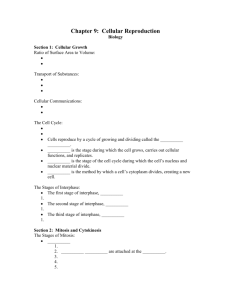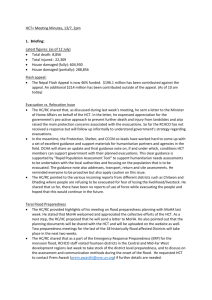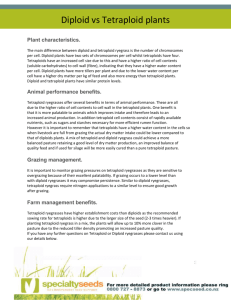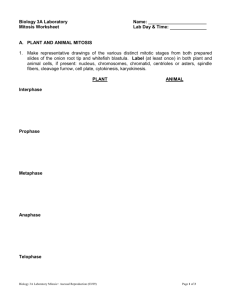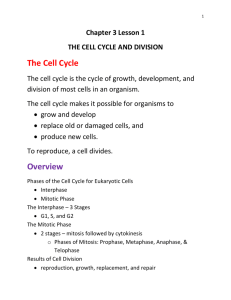Reduction mitosis of tetraploids generates pseudo-diploid
advertisement
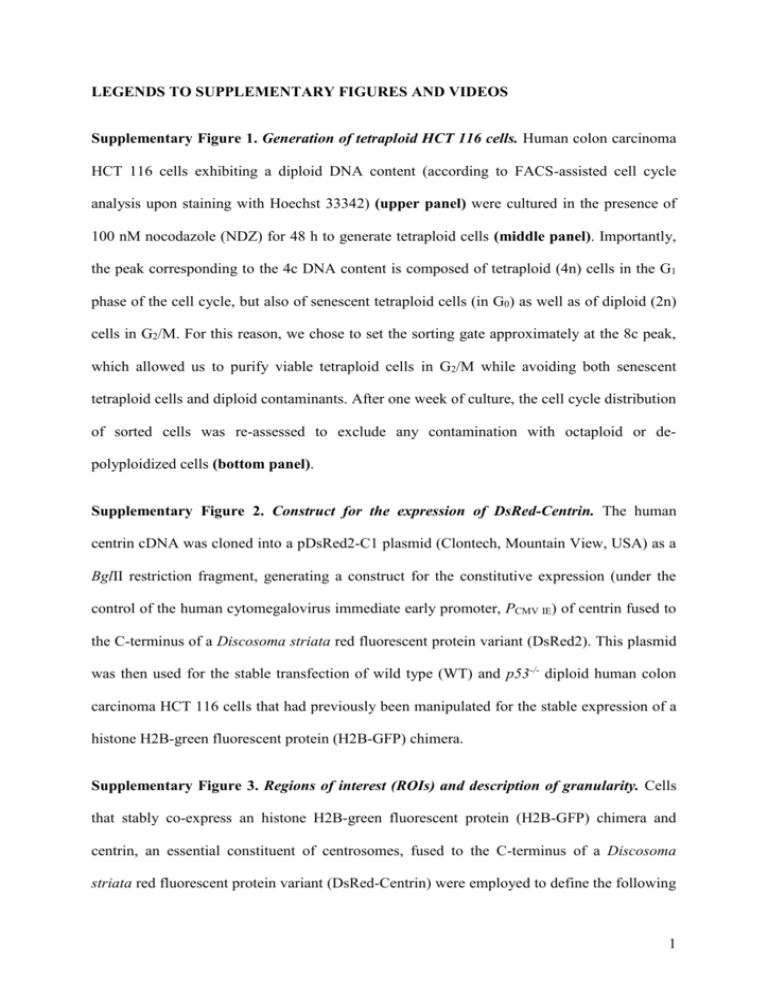
LEGENDS TO SUPPLEMENTARY FIGURES AND VIDEOS Supplementary Figure 1. Generation of tetraploid HCT 116 cells. Human colon carcinoma HCT 116 cells exhibiting a diploid DNA content (according to FACS-assisted cell cycle analysis upon staining with Hoechst 33342) (upper panel) were cultured in the presence of 100 nM nocodazole (NDZ) for 48 h to generate tetraploid cells (middle panel). Importantly, the peak corresponding to the 4c DNA content is composed of tetraploid (4n) cells in the G1 phase of the cell cycle, but also of senescent tetraploid cells (in G0) as well as of diploid (2n) cells in G2/M. For this reason, we chose to set the sorting gate approximately at the 8c peak, which allowed us to purify viable tetraploid cells in G2/M while avoiding both senescent tetraploid cells and diploid contaminants. After one week of culture, the cell cycle distribution of sorted cells was re-assessed to exclude any contamination with octaploid or depolyploidized cells (bottom panel). Supplementary Figure 2. Construct for the expression of DsRed-Centrin. The human centrin cDNA was cloned into a pDsRed2-C1 plasmid (Clontech, Mountain View, USA) as a BglII restriction fragment, generating a construct for the constitutive expression (under the control of the human cytomegalovirus immediate early promoter, PCMV IE) of centrin fused to the C-terminus of a Discosoma striata red fluorescent protein variant (DsRed2). This plasmid was then used for the stable transfection of wild type (WT) and p53-/- diploid human colon carcinoma HCT 116 cells that had previously been manipulated for the stable expression of a histone H2B-green fluorescent protein (H2B-GFP) chimera. Supplementary Figure 3. Regions of interest (ROIs) and description of granularity. Cells that stably co-express an histone H2B-green fluorescent protein (H2B-GFP) chimera and centrin, an essential constituent of centrosomes, fused to the C-terminus of a Discosoma striata red fluorescent protein variant (DsRed-Centrin) were employed to define the following 1 ROIs. A primary ROI denominated nucleus was defined by the area of GFP fluorescence, and a secondary ROI (denominated cell) consisted of the nuclear ROI plus a perinuclear extension of 10 pixels. The dot-like red fluorescence from DsRed-centrin constituted a third ROI denominated centrosome. The main parameter for the identification of mitosis was nuclear granularity (the presence of adjacent zones exhibiting heterogeneous fluorescence within the nucleus, corresponding to chromatin condensation), which was evaluated by comparing the average difference of the fluorescence intensity of adjacent pixels within the nuclear ROI to the mean fluorescence intensity of the entire nuclear ROI. Nuclear granularity progressively increases when cells leave interphase (upper left) and enter prophase first (upper right) and metaphase then (middle). Cell death by apoptosis is also accompanied by chromatin condensation (and hence increased nuclear granularity), but apoptotic cells usually display pyknotic nuclei (bottom left). Size thresholding of the nuclear ROI (minimal size allowed = 100 pixels) helped to exclude both early (bottom left) and late (bottom right) apoptotic events. Supplementary Figure 4. Generation of cell fate profiles. The repeated videomicroscopic observation of human colon carcinoma HCT 116 cells stably co-expressing H2B-GFP and DsRed-Centrin allowed for the identification of nine different sequences of events, which were defined and catalogued as a function of time. Cells that were arrested for a variable time in an abnormal metaphase either directly entered apoptosis, thereby undergoing Mitotic Catastrophe (red arrow), or reverted to an abnormal, polyploid interphase until the end of the experiment (Mitotic Slippage) (violet arrow). Upon reversion to interphase, some of these cells died while manifesting apoptotic features (Mitotic Slippage + Death in Interphase) (orange arrow). With the term Division, we refer to cells that underwent one round of normal mitosis (black arrow) followed by the interphase of the daughter cells until the end of the video recording. Cells that underwent Double Division engaged in two subsequent rounds of 2 normal mitosis (black arrow) separated by an apparently normal interphase (white arrow). The terms Division + Death in Interphase and Double Division + Death in Interphase refer to cells that underwent one or two rounds of apparently normal mitosis, respectively, but generated daughter cells that manifested apoptotic features before the end of the experiment (orange arrow). Some of the cells did not enter mitosis and then succumbed from Death in Interphase (orange arrow). Finally, a number of cells did not engage in mitosis throughout the entire duration of the experiment (Interphase without entering in mitosis) (green arrow). The time lapse of these events (also schematized in Figure 6c) has been used to create the cell fate profiles depicted in Figures 6d and e. Supplementary Figure 5. Detection of mitotic catastrophe in U2OS cells. Human osteosarcoma U2OS cells stably co-expressing H2B-GFP and DsRed-Centrin (which allow for the visualization of chromatin and centrosomes, respectively), were left untreated (a) or treated for 24 h with 1.5 µM paclitaxel (PTX) (b). On the left, representative fluorescence microphotographs (left) are shown (scale bar = 10 µm), wherein the abnormal metaphase configuration induced by PTX can be appreciated (b). This mitotic blockage can be easily deduced when nuclear granularity is plotted versus nuclear mean densitometry (right). Alternatively, U2OS cells were left untreated (Control) or treated with 1.5 µM PTX, 4 µM dimethylenastron (DIMEN), 300 nM nocodazole (NDZ), and 1.5 µM 7-hydroxystaurosporine (UCN-01) for 72 h (unless otherwise indicated), followed by the measurement of cell survival (determined by assessing the mean cell number in each image) (c), nuclear size (d), and centrosome number (e), as initially performed in HCT 116 cells engineered to co-express H2B-GFP and DsRed-Centrin (shown in Figure 5). Supplementary Video 1. Characterization of WT diploid HCT 116 cells stably coexpressing H2B-GFP and DsRed-Centrin. Wild type (WT) diploid human colon carcinoma HCT 116 cells engineered for the stable co-expression of H2B-GFP and DsRed-Centrin 3 (allowing for the detection of chromatin status and centrosome number, respectively) were monitored by time-lapse videomicroscopy for more than 36 h, to ensure normal cell cycle progression. Representative snapshots are shown in Figure 1a. Supplementary Video 2. Characterization of p53-/- tetraploid HCT 116 cells stably coexpressing DsRed-Centrin and H2B-GFP. p53-/- tetraploid human colon carcinoma HCT 116 cells genetically manipulated for the stable co-expression of H2B-GFP and DsRed-Centrin (which permit the visualization of chromatin and centrosomes, respectively) were monitored by time-lapse videomicroscopy for more than 36 h. p53-/- tetraploid HCT 116 cells coexpressing H2B-GFP and DsRed-Centrin displayed supernumerary centrosomes, multipolar metaphases and instances of asymmetrical cytokinesis, as previously reported for their untransfected counterparts. Representative snapshots are shown in Figure 1d. Supplementary Video 3. Mitotic catastrophe in WT diploid HCT 116 cells treated with PTX. Wild type (WT) diploid human colon carcinoma HCT 116 cells stably co-expressing H2B-GFP and DsRed-Centrin (which allow for the detection of chromatin status and centrosome number, respectively) were treated with 500 nM paclitaxel (PTX) for 8 h and then followed by time-lapse videomicroscopy for more than 36 h. Some of the classical features of mitotic catastrophe can be appreciated, including the shrinkage of mitotic nuclei taking place well before the incorporation of the vital dye TO-PRO®-3 (which reflects plasma membrane permeabilization). Representative snapshots are shown in Figure 6a. Supplementary Video 4. Mitotic slippage in p53-/- diploid HCT 116 cells treated with NDZ. p53-/- diploid human colon carcinoma HCT 116 cells engineered for the stable co-expression of H2B-GFP and DsRed-Centrin (allowing for the monitoring of chromatin status and centrosome number, respectively) were incubated with 100 nM nocodazole (NDZ) for 8 h and then imaged by time-lapse videomicroscopy for more than 36 h. NDZ-treated p53-/- diploid 4 cells tended to show mitotic slippage to interphase prior to cell death. In this movie, karyorrhexis occurred approximately 10 h after the recovery of interphase and preceded the incorporation of the vital dye TO-PRO®-3 (which is indicative of plasma membrane permeabilization). Representative snapshots are shown in Figure 6b. 5
